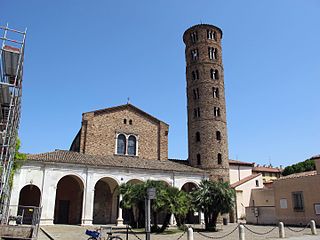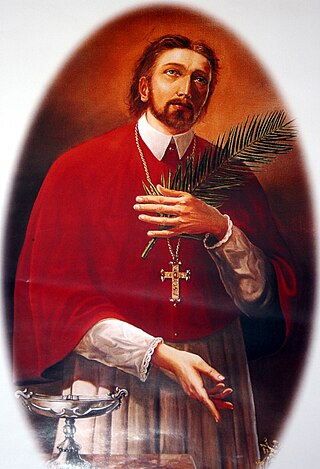
Baroque architecture is a highly decorative and theatrical style which appeared in Italy in the late 16th century and gradually spread across Europe. It was originally introduced by the Catholic Church, particularly by the Jesuits, as a means to combat the Reformation and the Protestant church with a new architecture that inspired surprise and awe. It reached its peak in the High Baroque (1625–1675), when it was used in churches and palaces in Italy, Spain, Portugal, France, Bavaria and Austria. In the Late Baroque period (1675–1750), it reached as far as Russia, the Ottoman Empire and the Spanish and Portuguese colonies in Latin America. In about 1730, an even more elaborately decorative variant called Rococo appeared and flourished in Central Europe.

San Saba is an ancient basilica church in Rome, Italy. It lies on the so-called Piccolo Aventino, which is an area close to the ancient Aurelian Walls next to the Aventine Hill and Caelian Hill.

The Church of St. Ignatius of Loyola at Campus Martius is a Latin Catholic titular church, of deaconry rank, dedicated to Ignatius of Loyola, the founder of the Society of Jesus, located in Rome, Italy. Built in Baroque style between 1626 and 1650, the church functioned originally as the chapel of the adjacent Roman College, which moved in 1584 to a new larger building and was renamed the Pontifical Gregorian University. It is one of the great 17th century preaching churches built by Counter-Reformation orders in the Centro Storico.

The Church of the Gesù is the mother church of the Society of Jesus (Jesuits), a Catholic religious order. Officially named Chiesa del Santissimo Nome di Gesù, its façade is "the first truly baroque façade", introducing the baroque style into architecture. The church served as a model for innumerable Jesuit churches all over the world, especially in Central Europe and in Portuguese colonies. Its paintings in the nave, crossing, and side chapels became models for art in Jesuit churches throughout Italy and Europe, as well as those of other orders. The Church of the Gesù is located at the Piazza del Gesù in Rome, and is one of the great 17th century preaching churches built by Counter-Reformation orders like the Jesuits in the Centro Storico.

The Basilica of Sant'Apollinare Nuovo is a basilica church in Ravenna, Italy. It was erected by the Ostrogothic king Theodoric the Great as his palace chapel during the first quarter of the 6th century. This Arian church was originally dedicated in 504 AD to "Christ the Redeemer".

Apollinaris of Ravenna is a Syrian saint, whom the Roman Martyrology describes as "a bishop who, according to tradition, while spreading among the nations the unsearchable riches of Christ, led his flock as a good shepherd and honoured the Church of Classis near Ravenna by a glorious martyrdom."

The Basilica of Sant'Apollinare in Classe is a church in Classe, Ravenna, Italy, consecrated on 9 May 549 by the bishop Maximian and dedicated to Saint Apollinaris, the first bishop of Ravenna and Classe.

Ferdinando Fuga was an Italian architect who was born in Florence, and is known for his work in Rome and Naples. Much of his early work was in Rome, notably, the Palazzo della Consulta (1732–7) at the Quirinal, the Palazzo Corsini (1736–54), the façade of the Santa Maria Maggiore (1741–3), and the Church of Sant'Apollinare (1742–8). He later moved to Naples and notably designed the Albergo de'Poveri (1751–81), the façade of the Church of the Gerolamini, and that of the Palazzo Giordano.

The Basilica of St. Stephen in the Round on the Caelian Hill is an ancient basilica and titular church in Rome, Italy. Commonly named Santo Stefano Rotondo, the church is Hungary's "national church" in Rome, dedicated to both Saint Stephen, the first Christian martyr, and Stephen I, the canonized first king of Hungary. The minor basilica is also the rectory church of the Pontifical Collegium Germanicum et Hungaricum.

Santo Stefano degli Ungheresi was the church of the Hungarians in Rome. Located next to the Vatican, the old church was pulled down in 1778, to make room for an extension of St. Peter's Basilica.

Stefano Pozzi was an Italian painter, designer, draughtsman, and decorator whose career was spent largely in Rome.
The Collegium Germanicum et Hungaricum, or simply Collegium Germanicum, is a German-speaking seminary for Catholic priests in Rome, founded in 1552. Since 1580 its full name has been Pontificium Collegium Germanicum et Hungaricum de Urbe. It is located on the Via di San Nicola da Tolentino.

Marko Stjepan Krizin, or Marko Križevčanin was a Croatian Roman Catholic priest, professor of theology and missionary, who was active in the 17th century. In the course of the struggle between Catholicism and Calvinism in the region then, he was executed for his faith. He has been declared a saint by the Catholic Church, the third Croat to be so honored.
The Pontifical Roman Major Seminary is the major seminary of the Diocese of Rome. It is located at the Archbasilica of Saint John Lateran. Since 2017, the rector of the seminary has been Gabriele Faraghini, a priest of the Little Brothers of Jesus Caritas.

San Macuto is a Catholic church located on Piazza di San Macuto in the Colonna rione of Rome, Italy. Located next to the Jesuit Collegio di San Roberto Bellarmino in the Palazzo Gabrielli-Borromeo, it is the only church in Italy dedicated to the 7th century Breton saint Malo.

Pontifical Roman Athenaeum S. Apollinare is a former pontifical university in Rome, named after St. Apollinaris of Ravenna. Its facilities are now occupied by the Pontifical University of the Holy Cross.

Fulda Cathedral is the former abbey church of Fulda Abbey and the burial place of Saint Boniface. Since 1752 it has also been the cathedral of the Diocese of Fulda, of which the Prince-Abbots of Fulda were created bishops. The abbey was dissolved in 1802 but the diocese and its cathedral have continued. The dedication is to Christ the Saviour. The cathedral constitutes the high point of the Baroque district of Fulda, and is a symbol of the town.

The Church of Saint Anne in the Vatican, known as Sant'Anna de' Palafrenieri, is a Catholic parish church dedicated to Saint Anne in Vatican City. The church is the parish church of the State of Vatican City and is placed under the jurisdiction of the Vicariate of the Vatican City and is located beside the Porta Sant'Anna, an international border crossing between Vatican City State and Italy.

The Domus Internationalis Paulus VI was established as a Foundation by Pope John Paul II on 6 January 1999. The purpose of the Domus is to accommodate clergy who are assigned to the diplomatic service of the Holy See, or who are officials of the Roman Curia. The Domus is at the Southern wing of the Palazzi di S. Apollinare. It is a historic Palazzo located in the ancient centre of Rome, and one of the four residences of the Officials of the Roman Curia in Rome; the other three are Domus Sanctae Marthae within the Vatican Walls, the Casa San Benedetto at via dell'Erba, and the Domus Romana Sacerdotalis at via Traspontina. The last two are located near the St. Peter's Square. Cardinals, bishops and priests who visit the Pope in Rome or who participate in the various apostolic works of the Holy See also stay at the Domus. The Domus is near the Vatican, notable Roman monuments, and famous sights.

La Clerecía is the name given to the building of the former Real Colegio del Espíritu Santo of the Society of Jesus, built in Salamanca between the 17th and 18th centuries. It is of baroque style. It differs the college, with an interesting cloister, and the church, with an impressive facade of three bodies. The name of Clerecía is due to an abbreviated denomination of its belonging to the Real Clerecía de San Marcos after the expulsion of the Jesuits from Spain.






















